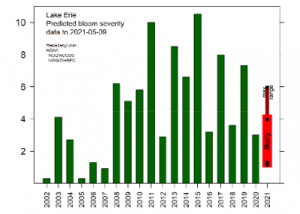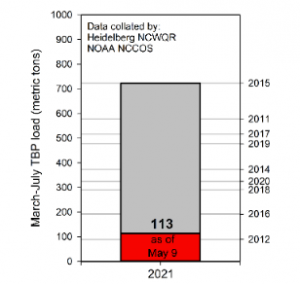Conservation, Homepage Slider, Water Quality
Western Lake Erie Harmful Algal Bloom Early Season Projection
By Stumpf, J. Noel (NOAA), Johnson (Heidelberg University), with assistance from Davenport and Tomlinson (NOAA), and D. Noel (Dayton Regional STEM School)
The severity of the western Lake Erie cyanobacterial harmful algal bloom (HAB) depends on input of bioavailable phosphorus from the Maumee River during the loading season (March 1-July 31).

This product gives an estimate of potential bloom severity based on a combination of measurements and forecasts of river discharge and phosphorus loads from now into July.
These projections will be updated with new data and weather models each week until the NOAA seasonal Lake Erie HAB Forecast is issued on June 30th, using measured spring phosphorus loads, and a more complete set of bloom models.
With data through May 9, the bloom is likely to be smaller than average, and it is expected to have a severity <6. We do not expect a large bloom (like 2017 or 2019).
Discharge of water from the Maumee River was below average in Marchand April, due to lower than average rainfall, which led to low phosphorus loads in early spring. Weather systems in May are bringing rain to the region, which will lead to a wetter than normal month that will bump up the phosphorus load.

There is uncertainty in the weather models on exact amounts, placement and intensity of rainfall in May which leads to uncertainty in the discharge, and the HAB forecast. In June, we expect a return to normal rainfall with less uncertainty.
Total bioavailable phosphorus (TBP) is the sum of dissolved phosphorus and the portion of particulate phosphorus available for HAB development. The TBP loads are projected based on Heidelberg University data, river forecasts from the National Weather Service Ohio River Forecast Center (through early July), and previous years to the end of July.
For more information visit: http://www.ncwqr.org or http://coastalscience.noaa.gov/research/habs/forecasting/